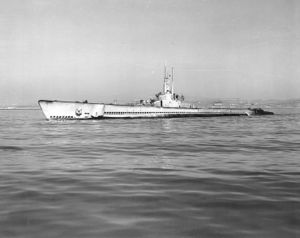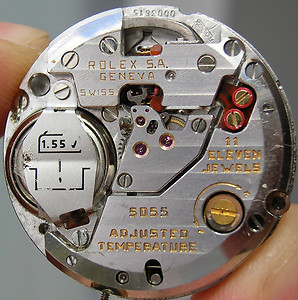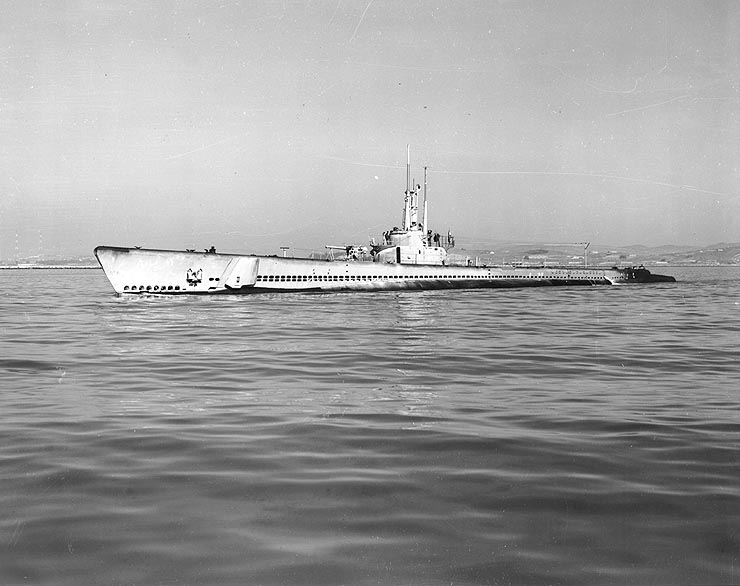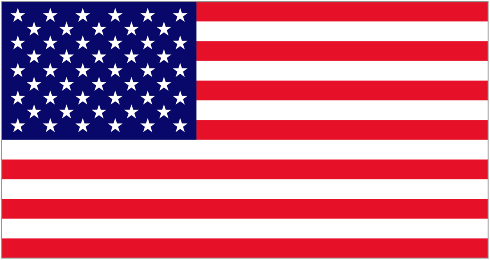History: USS Balao (SS/AGSS-285) was the lead ship of the United States Navy's Balao-class submarines during World War II and named for the balao, a small schooling marine fish.
Balao's keel was laid down on 26 June 1942 at the Portsmouth Navy Yard in Kittery, Maine. She was launched on 27 October 1942, sponsored by Mrs. Jane Aylward, wife of Lieutenant Commander Theodore C. Aylward, commissioned on 4 February 1943, Lieutenant Commander Richard H. Crane (USNA Class of 1931) in command; and reported to the United States Pacific Fleet.
Class: The Balao class was a successful design of United States Navy submarine used during World War II, and with 120 units completed, the largest class of submarines in the United States Navy. An improvement on the earlier Gato class, the boats had slight internal differences. The most significant improvement was the use of thicker, higher yield strength steel in the pressure hull skins and frames, which increased their test depth to 400 feet (120 m). Tang actually achieved a depth of 612 ft (187 m) during a test dive, and exceeded that test depth when taking on water in the forward torpedo room while evading a destroyer.
The Balaos were similar to the Gatos, except they were modified to increase test depth from 300 ft (90 m) to 400 ft (120 m). In late 1941, two of the Navy’s leading submarine designers, Captain Andrew McKee and Commander Armand Morgan, met to explore increasing diving depth in a redesigned Gato. A switch to a new High-Tensile Steel (HTS) alloy, combined with an increase in hull thickness from 9⁄16 inch (14.3 mm) to 7⁄8 inch (22.2 mm), would result in a test depth of 450 ft (140 m) and a collapse depth of 900 ft (270 m). However, the limited capacity of the trim pump at deep depths, and lack of time to design a new pump, caused Rear Admiral E. L. Cochrane, Chief of the Bureau of Ships, to limit test depth to 400 ft (120 m). Fortunately, in 1944 a redesigned Gould centrifugal pump replaced the noisy early-war pump, and effective diving depth was increased.
The Balaos were similar to the Gatos, except they were modified to increase test depth from 300 ft (90 m) to 400 ft (120 m). In late 1941, two of the Navy’s leading submarine designers, Captain Andrew McKee and Commander Armand Morgan, met to explore increasing diving depth in a redesigned Gato. A switch to a new High-Tensile Steel (HTS) alloy, combined with an increase in hull thickness from 9⁄16 inch (14.3 mm) to 7⁄8 inch (22.2 mm), would result in a test depth of 450 ft (140 m) and a collapse depth of 900 ft (270 m). However, the limited capacity of the trim pump at deep depths, and lack of time to design a new pump, caused Rear Admiral E. L. Cochrane, Chief of the Bureau of Ships, to limit test depth to 400 ft (120 m). Fortunately, in 1944 a redesigned Gould centrifugal pump replaced the noisy early-war pump, and effective diving depth was increased.
Nationality: The U.S. is a country of 50 states covering a vast swath of North America, with Alaska in the northwest and Hawaii extending the nation’s presence into the Pacific Ocean. Major Atlantic Coast cities are New York, a global finance and culture center, and capital Washington, DC. Midwestern metropolis Chicago is known for influential architecture and on the west coast, Los Angeles' Hollywood is famed for filmmaking.
Item created by: Lethe on 2019-04-04 14:05:38. Last edited by gdm on 2019-04-04 14:11:03
If you see errors or missing data in this entry, please feel free to log in and edit it. Anyone with a Gmail account can log in instantly.
If you see errors or missing data in this entry, please feel free to log in and edit it. Anyone with a Gmail account can log in instantly.









